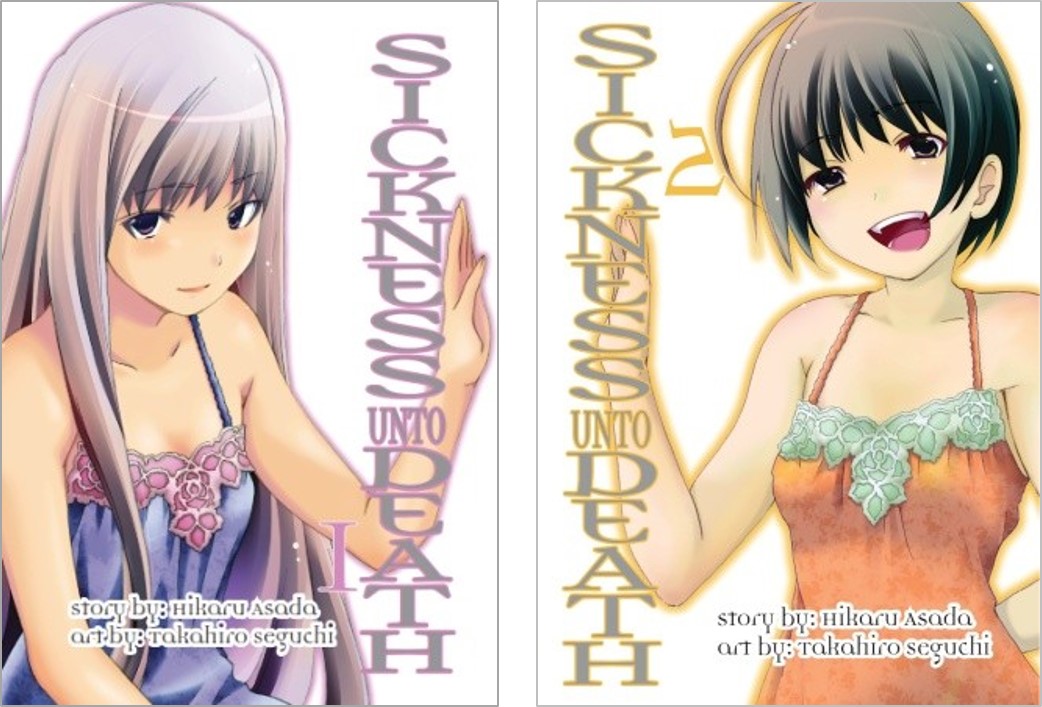24 Jan / Sickness Unto Death (vols. 1-2) by Hikaru Asada, illustrated by Takahiro Seguchi, translated by Vertical, Inc.

 Determined to become a clinical psychologist, young Futaba arrives in an unnamed city to begin college. Before he even gets to his lodgings – arranged through a friend of his father’s – he helps a young woman who collapses in a crowded plaza. While he can’t deny her strange beauty, he’s more struck by her lifelessness: her colorless hair, pale skin “like glass,” her “mannequin’s” hand, her body “so frail it could snap.”
Determined to become a clinical psychologist, young Futaba arrives in an unnamed city to begin college. Before he even gets to his lodgings – arranged through a friend of his father’s – he helps a young woman who collapses in a crowded plaza. While he can’t deny her strange beauty, he’s more struck by her lifelessness: her colorless hair, pale skin “like glass,” her “mannequin’s” hand, her body “so frail it could snap.”
When he reaches his lodgings-to-be, he’s not only surprised he’ll be living in a mansion, but that the owner is none other than the sickly young woman. “Miss Emiru suffers from a terminal illness of the spirit,” Kuramoto – the mansion’s butler and only other resident – explains. Surrounded by nightmares, monsters, and death (oh, my!), Emiru proves to be an irresistible psychological challenge. How could such a caring (testosteroned!) young man turn away from someone so gorgeously needy …? Doctor/patient distance be damned (uhhh, he’s still just a student, so that’s okay?!). Will Futaba be able to save his own sanity as he battles her past?
The title is a nod to Danish philosopher Søren Kierkegaard, who originally published the text in 1849 under what seems today to be a comical pseudonym, Anti-Climacus. You probably don’t need to read the eponymous psychological treatise on despair to get full benefit of this two-volume manga. That said, while Sickness might be less venerable than its namesake, it’s also not without subtle depth.
Take names, for example – a whole meta-narrative is happening in their possible literal meanings. As a new student, our young man Futaba (‘a bud, a sprout’) is a vessel for potential when he presents himself at the Ariga mansion. There he first faces Kuramoto (‘the foundation of darkness’) who has faithfully served the young heiress through dark, difficult times. Futaba next formally meets Emiru (‘to look at the picture) Ariga (‘to be a picture’), who is a mere semblance of who she once was; Ariga could also mean ‘to be congratulatory,’ perhaps a reference to her outcome as a result of Futaba’s intervention.
What happens to Emiru certainly raises thought-provoking questions, especially about (possible spoiler alert!) so-called ‘true’ identity in the case of multiple personalities, and who gets to determine who is ‘real’ and who is not. After reading both volumes, try this: line up the covers side by side and ask – whether doctor or patient, what would you do?
Readers: Young Adult, Adult
Published: 2013 (United States)
